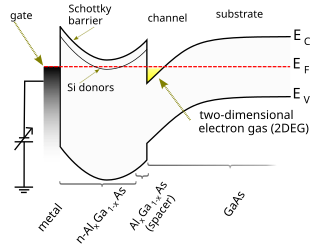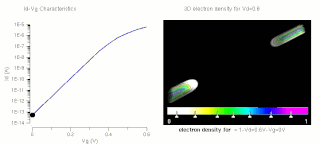Qualitative description
Band bending can be induced by several types of contact. In this section metal-semiconductor contact, surface state, applied bias and adsorption induced band bending are discussed.

Metal-semiconductor contact induced band bending
Figure 1 shows the ideal band diagram (i.e. the band diagram at zero temperature without any impurities, defects or contaminants) of a metal with an n-type semiconductor before (top) and after contact (bottom). The work function is defined as the energy difference between the Fermi level of the material and the vacuum level before contact and is denoted by . When the metal and semiconductor are brought in contact, charge carriers (i.e. free electrons and holes) will transfer between the two materials as a result of the work function difference .
If the metal work function () is larger than that of the semiconductor (), that is , the electrons will flow from the semiconductor to the metal, thereby lowering the semiconductor Fermi level and increasing that of the metal. Under equilibrium the work function difference vanishes and the Fermi levels align across the interface. A Helmholtz double layer will be formed near the junction, in which the metal is negatively charged and the semiconductor is positively charged due to this electrostatic induction. Consequently, a net electric field is established from the semiconductor to the metal. Due to the low concentration of free charge carriers in the semiconductor, the electric field cannot be effectively screened (unlike in the metal where in the bulk). This causes the formation of a depletion region near the semiconductor surface. In this region, the energy band edges in the semiconductor bend upwards as a result of the accumulated charge and the associated electric field between the semiconductor and the metal surface.
In the case of , electrons are shared from the metal to the semiconductor, resulting in an electric field that points in the opposite direction. Hence, the band bending is downward as can be seen in the bottom right of Figure 1.
One can envision the direction of bending by considering the electrostatic energy experienced by an electron as it moves across the interface. When , the metal develops a negative charge. An electron moving from the semiconductor to the metal therefore experiences a growing repulsion as it approaches the interface. It follows that its potential energy rises and hence the band bending is upwards. In the case of , the semiconductor carries a negative charge, forming a so-called accumulation layer and leaving a positive charge on the metal surface. An electric field develops from the metal to the semiconductor which drives the electrons towards the metal. By moving closer to the metal the electron could thus lower its potential energy. The result is that the semiconductor energy band bends downwards towards the metal surface. [4]
Surface state induced band bending

Despite being energetically unfavourable, surface states may exist on a clean semiconductor surface due to the termination of the materials lattice periodicity. Band bending can also be induced in the energy bands of such surface states. A schematic of an ideal band diagram near the surface of a clean semiconductor in and out of equilibrium with its surface states is shown in Figure 2 . The unpaired electrons in the dangling bonds of the surface atoms interact with each other to form an electronic state with a narrow energy band, located somewhere within the band gap of the bulk material. For simplicity, the surface state band is assumed to be half-filled with its Fermi level located at the mid-gap energy of the bulk. Furthermore, doping is taken to not be of influence to the surface states. This is a valid approximation since the dopant concentration is low.
For intrinsic semiconductors (undoped), the valence band is fully filled with electrons, whilst the conduction band is completely empty. The Fermi level is thus located in the middle of the band gap, the same as that of the surface states, and hence there is no charge transfer between the bulk and the surface. As a result no band bending occurs. If the semiconductor is doped, the Fermi level of the bulk is shifted with respect to that of the undoped semiconductor by the introduction of dopant eigenstates within the band gap. It is shifted up for n-doped semiconductors (closer to the conduction band) and down in case of p-doping (nearing the valence band). In disequilibrium, the Fermi energy is thus lower or higher than that of the surface states for p- and n-doping, respectively. Due to the energy difference, electrons will flow from the bulk to the surface or vice versa until the Fermi levels become aligned at equilibrium. The result is that, for n-doping, the energy bands bend upward, whereas they bend downwards for p-doped semiconductors. [5] Note that the density of surface states is large () in comparison with the dopant concentration in the bulk (). Therefore, the Fermi energy of the semiconductor is almost independent of the bulk dopant concentration and is instead determined by the surface states. This is called Fermi level pinning.
Adsorption induced band bending

Adsorption on a semiconductor surface can also induce band bending. Figure 3 illustrates the adsorption of an acceptor molecule (A) onto a semiconductor surface. As the molecule approaches the surface, an unfilled molecular orbital of the acceptor interacts with the semiconductor and shifts downwards in energy. Due to the adsorption of the acceptor molecule its movement is restricted. It follows from the general uncertainty principle that the molecular orbital broadens its energy as can be seen in the bottom of figure 3. The lowering of the acceptor molecular orbital leads to electron flow from the semiconductor to the molecule, thereby again forming a Helmholtz layer on the semiconductor surface. An electric field is set up and upwards band bending near the semiconductor surface occurs. For a donor molecule, the electrons will transfer from the molecule to the semiconductor, resulting in downward band bending. [1]
Applied bias induced band bending
When a voltage is applied across two surfaces of metals or semiconductors the associated electric field is able to penetrate the surface of the semiconductor. Because the semiconductor material contains little charge carriers the electric field will cause an accumulation of charges on the semiconductor surface. When , a forward bias, the band bends downwards. A reverse bias () would cause an accumulation of holes on the surface which would bend the band upwards. This follows again from Poisson's equation. [5]
As an example the band bending induced by the forming of a p-n junction or a metal-semiconductor junction can be modified by applying a bias voltage . This voltage adds to the built-in potential () that exists in the depletion region (). [6] Thus the potential difference between the bands is either increased or decreased depending on the type of bias that is applied. The conventional depletion approximation assumes a uniform ion distribution in the depletion region. It also approximates a sudden drop in charge carrier concentration in the depletion region. [7] Therefore the electric field changes linearly and the band bending is parabolic. [8] Thus the width of the depletion region will change due to the bias voltage. The depletion region width is given by:
and are the boundaries of the depletion region. is the dielectric constant of the semiconductor. and are the net acceptor and net donor dopant concentrations respectively and is the charge of the electron. The term compensates for the existence of free charge carriers near the junction from the bulk region.









































